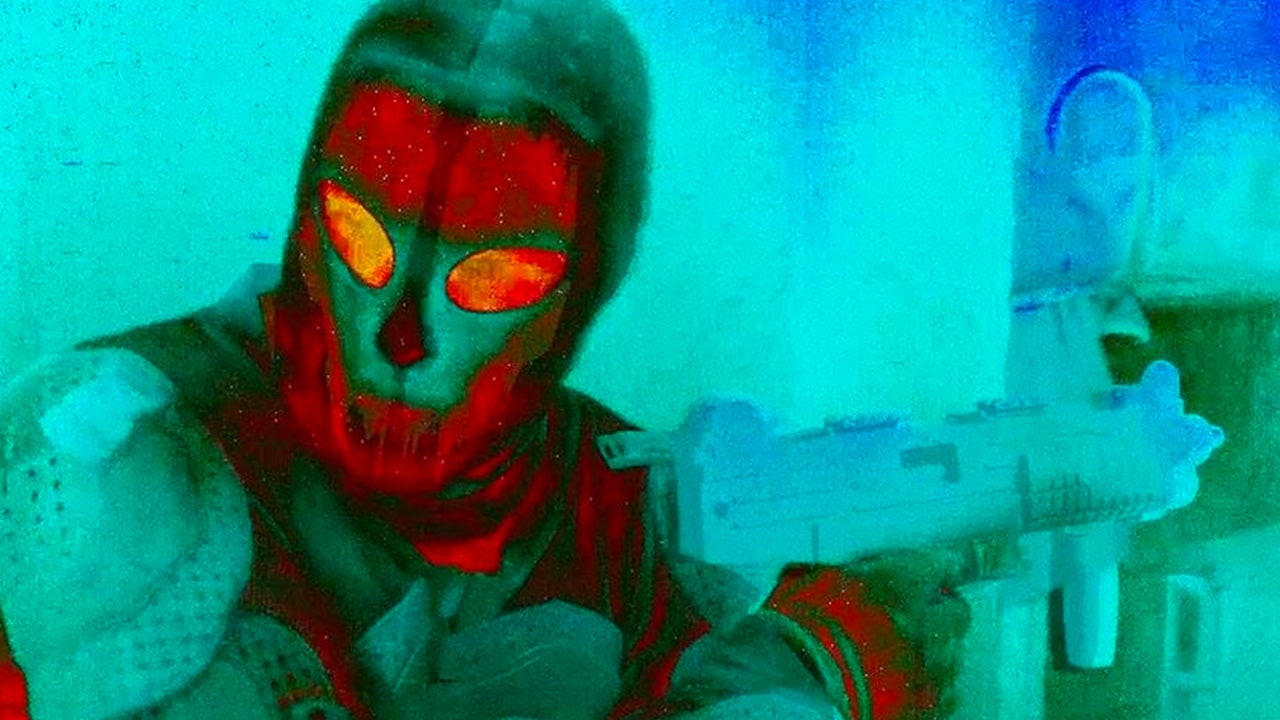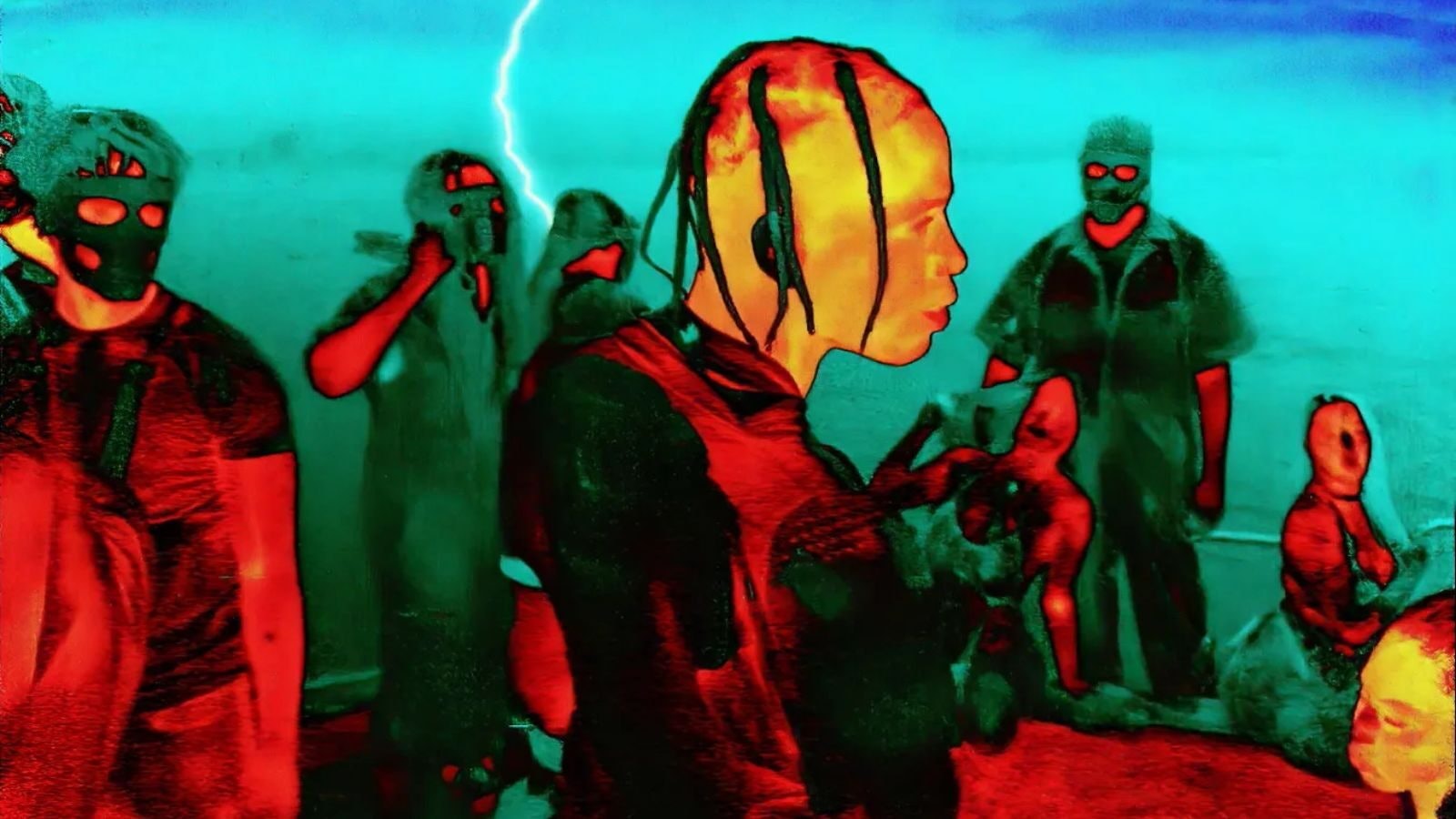
“The old world is no more.”
So intones Jordi Mollà’s seasoned hitman through the nebulous, narcotized haze of Harmony Korine’s Aggro Dr1ft, echoing the filmmaker’s own much-publicized perspective that movies as we know them are dying, soon to be displaced by “something else” that better suits overstimulated Gen Z attention spans.
An immersive yet disorienting sensory experience, set in a tropical hell of wandering assassins and horned demons that tower like kaiju, Aggro Dr1ft can be most clearly read as Korine’s attempt to capture that elusive “something else.” The film, shot by Korine and director of photography Arnaud Potier with a thermal lens, uses infrared cameras to create a neon-negative night-vision aesthetic that Korine calls “gamecore,” owing in part to a postproduction process during which its images are filtered through layers of 3D imaging, visual effects, and AI by a gaming engine, all interacting to texture costumes, masks, and tattoos in ephemeral, rippling hues.
As the first project from Korine’s broadly defined artistic banner Edglrd (pronounced “edgelord,” naturally), Aggro Dr1ft is certainly an ambitious start to the company’s mission to merge the aesthetics of cinema, video games, and social media platforms into free-flowing, multi-sensory experiences. Korine has described Edglrd as less of a film studio or production company than a creative collective through which artists, game developers, skateboarders, fashion designers, and tech-savvy disruptors can experiment with new media forms. Indeed, Aggro Dr1ft’s aesthetic was mostly inspired by TikTok, first-person shooters, and the questions that both left Korine wrestling with: “What is the feeling of being inside of a game? Or even something close to a drug experience? Is there a physical kind of component to what you’re watching? Is there something that blurs the line between reality and unreality?”
But is Aggro Dr1ft actually successful at conveying all those things? Not exactly. A viewing experience already infamous for generating mass walkouts at festivals in Venice, Toronto, and New York, Aggro Dr1ft is its own chaotic, confrontational sort of concoction — a response to the media paradigm Korine has identified that, in its eerily dissociative rhythms, will actively repel some viewers, will have others reaching for their phones, and will surely make converts of a few midnight-movie buffs in the crowd.

The sensation of watching all 80 minutes of Aggro Dr1ft — and listening to it, given that the blaring, ambient score by AraabMuzik feels as central to Korine’s mood of low-level stimulation as its beautifully slurried, hallucinatory images — takes precedence over its dreamlike, semi-coherent narrative flow. What does become apparent is that Mollà’s aforementioned killer-for-hire, Bo, has grown weary of his existence as “the world’s greatest assassin,” driving his glorious Corvette through a GTA V-ified vision of Miami — full of strip clubs and luxury yachts (and luxury yachts that operate more like strip clubs) — from one assignment to another.
Eventually, Bo decides to abandon his next job and instead travel to the mansion where a massively jacked and potentially demonic crime lord lies in wait, terrorizing women in cages and lording it over his domain with a katana, like the final boss in a Final Fantasy game, as diminutive henchmen glower nearby. Meanwhile, Bo’s wife patiently writhes around in bed, waiting for her husband to return home and repeatedly declaring her love. (No screenwriter is credited, and it feels possible, even likely, that the script was as AI-driven as the visuals.)
There’s always been a surreally mythic dimension to Korine’s work; in everything from his grotesque-realist debut Gummo to beach-noir odyssey Spring Breakers, he’s sent audiences spiraling through the smoking debris of the American dream, examining the nature of evil and its relationship to excess, often within a morally bankrupt vision of Florida where shadows seep inside the sunshine. The vaporwave provocations of Aggro Dr1ft feel not entirely dissimilar to either film in their sensorily heightened, spiritually amoral affect, and the project as a whole retains a self-reflexive whiff of consumer-capitalist critique. (Alongside scenes where Travis Scott as fork-tongued protégé Zion broods the night away on a party yacht, bemoaning the pressures of his lavish lifestyle, one expects at every turn James Franco’s drug-dealing Alien to spring forth to command, “Look at all ma shit!”)
And it should be said that Korine’s embrace of cutting-edge technology hasn’t altered the apocalyptic tenor of his work so much as guided it down the same cybernetically enhanced pathways much of contemporary science-fiction has traveled. As with Spring Breakers, a fetish-object fantasia of half-naked bodies and gleaming gun-metal, and The Beach Bum, a melancholic picaresque that played like the stoner comedy’s last stand, Aggro Dr1ft envisions a dystopian other-realm in which the grammar of video games — with their looping, repetitive mechanics; stilted dialogue; passionless ultraviolence; and a computerized core of wires and circuit boards, literally seen coursing inside characters like veins — has been imposed over reality alongside their aesthetics.

The results are as pointedly nihilistic as they are nakedly existential; if the film reaches toward futurity in the manner of its creation, Korine’s vision is nevertheless one of a fully derealized purgatory, in which even these infrared impressions of assassins and strippers remain listlessly trapped in the roles that a culture of materialist juvenilia has fashioned for them. One gets the sense not of a humanity evolved through technology, but consumed by it. Aggro Dr1ft’s heat-vision aesthetic adds another layer of abstraction that’s at once vibrant and unvaried, seductive and soporific, in how it renders its world of red-yellow-and-green signatures. While Floridian landscapes are transformed into psychedelic tableaux, all deep-red skies and fluorescent-blue oceans, details such as facial features are obscured, dehumanizing the actors until they resemble video-game avatars, if not nonplayable characters (NPCs). Their archetypal characterization and scant dialogue only compounds this sensation. Aggro Dr1ft’s characters feel as suspended between reality and unreality as the film itself, part of its simulation despite the actors embodying them within.
Whether all of this abrasive formal experimentation ultimately adds up to more than an impressive tech demo is still, in this reviewer’s mind, an open question. But Aggro Dr1ft gives audiences enough time to interrogate their own responses to the central challenge Korine and Edglrd have posed to more conventional modes of filmmaking. In his efforts to explore the next frontier of content, rather than movies, Korine appears to be directly toying with audiences’ diminished attention spans.
Korine describes Aggro Dr1ft as a foray into primarily “vibe-based storytelling,” and its meandering progression — not playing out linearly so much as drowsily ebbing and flowing in strange, acid-washed snatches — bears that out. Korine has designed Aggro Dr1ft with enough dead air for audiences to drink in the iridescent sensations of his simulation, consider its immersive and embryonic design, and (if they so choose) wander to another digital realm without losing track of its woozily oneiric tone.
Still, those on its particular wavelength will likely embrace Aggro Dr1ft with open arms as a trance-like endurance test, operating in a brazenly artificial zone of its own. Hypnotic, hilarious, stupefying, and certainly daring, it’s an experience that, if never convincing as a way forward for filmmaking, at least makes a halfway-compelling case for Edglrd and Korine’s own intriguing new direction as an artist.







